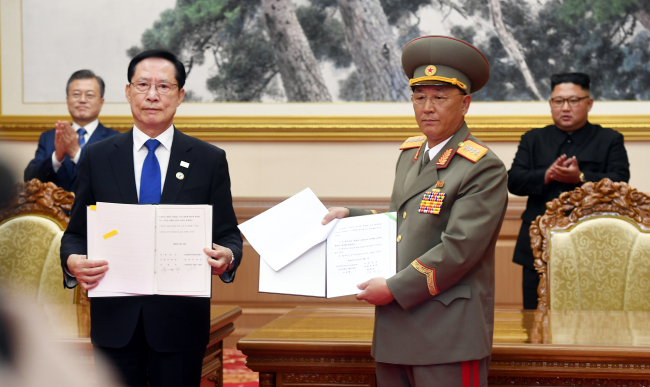The militaries of the two Koreas on Wednesday agreed to turn a large swath of the border area into a buffer zone, pledging to prevent any form of cross-border hostilities amid continued inter-Korean detente.
In a document signed by the two Koreas’ defense chiefs, the two sides said they would establish a “no-fly zone” inside the heavily fortified Demilitarized Zone. They also agreed to suspend military drills near the DMZ and the disputed waters in the West Sea. The measure will take effect on Nov. 1.
The two Koreas also agreed on a series of measures to “practically disarm” the DMZ and the Joint Security Area controlled by the US-led United Nations Command. They agreed to pull back 11 guard posts from the DMZ and to remove land mines near the JSA by the end of this year.
 |
South Korea’s Defense Minister Song Young-moo and his North Korean counterpart No Kwang-chol in Pyongyang (Joint Press Corps) |
“It is a practical measure to ensure both sides do not shoot each other amid the denuclearization process,” Choi Jong-kun, secretary to President Moon Jae-in for peace and arms control, said during a press briefing in Pyongyang.
Appended to the summit agreement between President Moon Jae-in and North Korea’s leader Kim Jong-un, the military agreement is aimed at preventing accidental skirmishes and enhancing mutual trust -- a pledge made at the border village of Panmunjom between Moon and Kim in April.
In the Panmunjom Declaration, Moon and Kim agreed to prevent any form of hostile activities against each other in all cross-border areas, including land, air and sea. The two leaders pledged to establish a “permanent peace regime” on the Korean Peninsula
While the South Korean government described the military agreement as “equivalent to declaring an end to the Korean War,” some experts said the measures have “adverse effect” on South Korea’s readiness posture in the absence of concrete steps for denuclearization by the North.
“For South Korea, the best arms control measure is denuclearization of North Korea,” said Shin Beom-chul, a senior researcher at the Asan Institute for Policy Studies. As long North Korea has nuclear weapons, reduction of conventional weapons is a disadvantage to the South, according to Shin.
According to the military agreement, the two Koreas’ artillery drills and maneuvering field trainings conducted by units above Army companies are prohibited within 5 kilometers from the Military Demarcation Line, which bisects the two Koreas.
Regarding the no-fly zone, fixed-wing aircraft are banned from flying too close to the MDL, with the exception of rescue missions and natural disasters. The restricted airspace covers a 80-kilometer-wide area in the east part of the MDL and 40 kilometers in the west part of the land border.
To prevent any miscalculation, the two militaries agreed to establish a detailed procedure for notifying each other about sensitive moves. They also agreed to establish a joint military committee and direct telephone communications system.
“We have come up with a common standard of operation to prevent miscalculations,” Presidential Secretary Choi said. “Through this, the two Koreas will act on a principle of communicating first before taking actions.”
Other confidence-building measures agreed on included pulling 11 guard posts along the DMZ, removing land mines buried there, and excavating the remains of the 1950-53 Korean War.
The two military also agreed to establish “peace waters” near the maritime border with North Korea inside the West Sea. The border area of the West Sea has seen bloody skirmishes between the two Koreas in the past.
While the two Koreas agreed to establish the buffer zone near the border, known as the Northern Limit Line, Seoul’s Defense Ministry said the disputed maritime border was not brought up during the negotiations amid the concern that South Korea might yield concession on its territory.
“Our position will never change on the NLL,” a senior defense official told reporters, requesting anonymity due to the sensitivity of the issue. “The NLL was never an agenda item for discussion. … We will continue to have discussions with North Korea.”
Some analysts said designating a no-fly zone above the DMZ could unnerve the US and restrict its reconnaissance abilities inside the border region, whose southern parts are controlled by the US-led United Nations’ Forces.
Since the Korean War ended with the armistice, not a peace treaty, the UNC has been in charge of enforcing the armistice agreement. Military skirmishes and other cross-border accidents that happen there must undergo probes by the UNC.
“I’m not sure whether the UNC, I mean US forces, would agree to such an agreement,” said Kim Dae-young, a military analysts at the Korea Research Institute for National Strategy. “If the two Koreas try to push the deal without consultation with the US, it’s a bad idea.”
The Defense Ministry official said consultations are underway with the UNC, highlighting that establishing a no-fly zone would not weaken the allies’ surveillance abilities to monitor North Korea’s military movement.
By Yeo Jun-suk & Joint Press Corps (
jasonyeo@heraldcorp.com)




![[Today’s K-pop] Blackpink’s Jennie, Lisa invited to Coachella as solo acts](http://res.heraldm.com/phpwas/restmb_idxmake.php?idx=644&simg=/content/image/2024/11/21/20241121050099_0.jpg)



